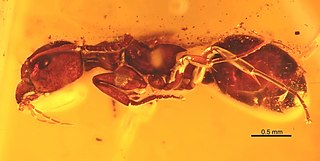
The Hepialoidea are the superfamily of "ghost moths" and "swift moths".

Zhucheng is a county-level city in the southeast of Shandong province, People's Republic of China. It is under the administration of Weifang city and had at the 2010 census a population of 1,086,222 even though its built-up area is much smaller.

Dolichoderus is a genus of ants found worldwide.
Alloiomma is an extinct genus of ants that once belonged to the subfamily Dolichoderinae. A. changweiensis was the first extinct species to be discovered by Zhang in 1989, and another fossil species was discovered in 1994, known as A.differentialis. The ants were endemic to China.
Elaphrodites is an extinct genus of ants of the subfamily Dolichoderinae. Two fossils were discovered and described by Zhang in 1989.
Eurymyrmex is an extinct genus of ant in the Formicidae subfamily Dolichoderinae. The genus contains a single described species Eurymyrmex geologicus. It was described in 1994, where the first fossils of the ant were found in China.
Myopopone sinensis is an extinct species of ant in the genus Myopopone. Fossils were discovered in 1989 in China, and was later described by Zhang in that year.
Iridomyrmex shandongicus is an extinct species of ant in the genus Iridomyrmex. Described by Zhang in 1989, fossils were originally found in 1989, and out of all the fossils in the genus, this one has strongest support that it belongs in the genus.

Dolichoderus balticus is an extinct species of Eocene ant in the genus Dolichoderus. Described by Mayr in 1868, the fossils of a worker, queen and male of the species were discovered in the Baltic Amber.
Dolichoderus evolans is an extinct species of Miocene ant in the genus Dolichoderus. Described by Zhang in 1989, the fossilised species was discovered in China, where a possible queen has been described.
Dolichoderus jiaoyanshanensis is an extinct species of ant in the genus Dolichoderus. Fossils containing the species were found in China, and it was described by Hong in 1985. The ant is from Shanwang and is presumed to be a Miocene insect.
Dolichoderus luridivenosus is an extinct species of Miocene ant in the genus Dolichoderus. Described by Zhang, Sun and Zhang in 1994, the species was discovered after a fossil of a queen was found in China.

Dolichoderus tertiarius is an extinct species of Eocene ant in the genus Dolichoderus. Described by Mayr in 1868, fossils of a worker, queen and male were discovered and described in the Baltic amber.
Dolichoderus transversipetiolaris is an extinct species of Miocene ant in the genus Dolichoderus. Described by Zhang, Sun and Zhang in 1994, the species was discovered after a fossil of a queen was found in China.
Liometopum eremicum is an extinct species of Miocene ant in the genus Liometopum. Described by Zhang in 1989, the fossils were found in China.
Liometopum lubricum is an extinct species of Miocene ant in the genus Liometopum. Described by Zhang, Sun and Zhang 1994, the fossils were found in China.
Liometopum potamophilum is an extinct species of Miocene ant in the genus Liometopum. Described by Zhang in 1989, the fossils were found in China.
Tapinoma baculum is an extinct species of ant in the genus Tapinoma. Described by Zhang in 1989, fossils of the species were found in China.

Laiyangosaurus is a genus of saurolophine hadrosaurid from the Late Cretaceous Jingangkou Formation of China. It is known from one species, L.youngi, found in the Laiyang Basin within the province of Shandong.
Sinankylosaurus is a genus of dinosaur, originally described as an ankylosaur, from the late Cretaceous Period of Shandong, China. The genus contains a single species, Sinankylosaurus zhuchengensis, known from a nearly complete right ilium. The describers claim that the discovery of Sinankylosaurus further demonstrates the similarity between dinosaurs of eastern Asia and western North America.





